| Article ID | Journal | Published Year | Pages | File Type |
|---|---|---|---|---|
| 305585 | Soil and Tillage Research | 2015 | 10 Pages |
•No-till lysimeter drainage was greater than plow-till during the first two months.•No-till nitrate leaching was also greater than plow-till the first two months.•Nitrate leaching was similar for both tillage practices after the first two months.•Timing nitrogen applications in phase with crop demand reduced nitrate leaching.
Management strategies for winter wheat (Triticum aestivum L., cultivar Pioneer “2548”) in the Northern Atlantic Coastal-Plain region of the USA must balance agronomic production with practices to reduce nitrate-N (NO3-N) leaching, because much of this region lies within the Chesapeake Bay watershed. Winter wheat in this region is commonly grown using no-tillage (NT), but few studies have evaluated the effects of NT on NO3-N leaching for winter wheat. A four-year lysimeter study was conducted in Beltsville, Maryland by growing winter wheat in eight tension-drained undisturbed soil-column lysimeters (41 cm diameter by 100 cm deep) configured to exclude runoff, to compare the effects of NT vs. simulated plow-tillage (PT) and N fertilization practices on drainage volumes and NO3-N leaching. Additional data documented wheat total N uptake and bromide leaching. The temporal pattern of drainage showed that NT produced significant, but modestly higher, drainage volumes than PT during fall establishment (mid-Oct. to mid-Dec.), which increased the potential for NO3-N leaching, especially following high rainfalls. However, the greater risk of NO3-N leaching with NT during establishment decreased in the spring as tillage effects subsided and wheat water-use and N uptake became dominant. The increased fall leaching risk with NT can be managed by reducing fall-N applications, but both NT and PT can benefit from reduced NO3-N leaching resulting from spring split-N applications. The final NO3-N leaching losses depend on the interactions of precipitation timing and amount, fertilizer-N rate and timing, and initial soil water status. Additional winter-wheat NO3-N leaching research is needed to study to a wider range of soils, to assess high-residue vertical-tillage implements, and to evaluate precision application of spring fertilizer-N.
